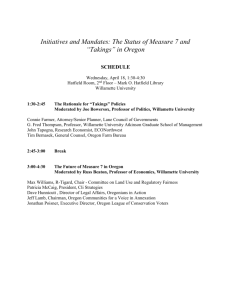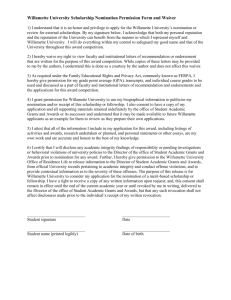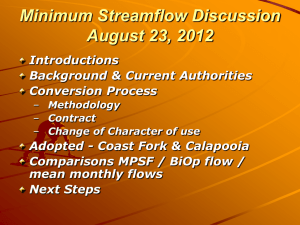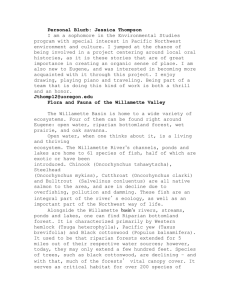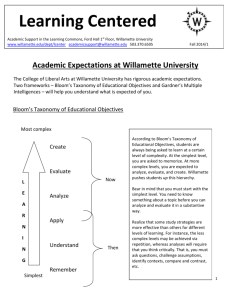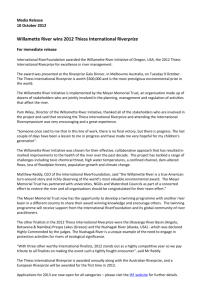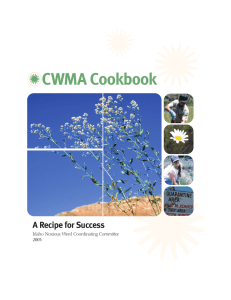Upper-Willamette CWMA Profile
advertisement
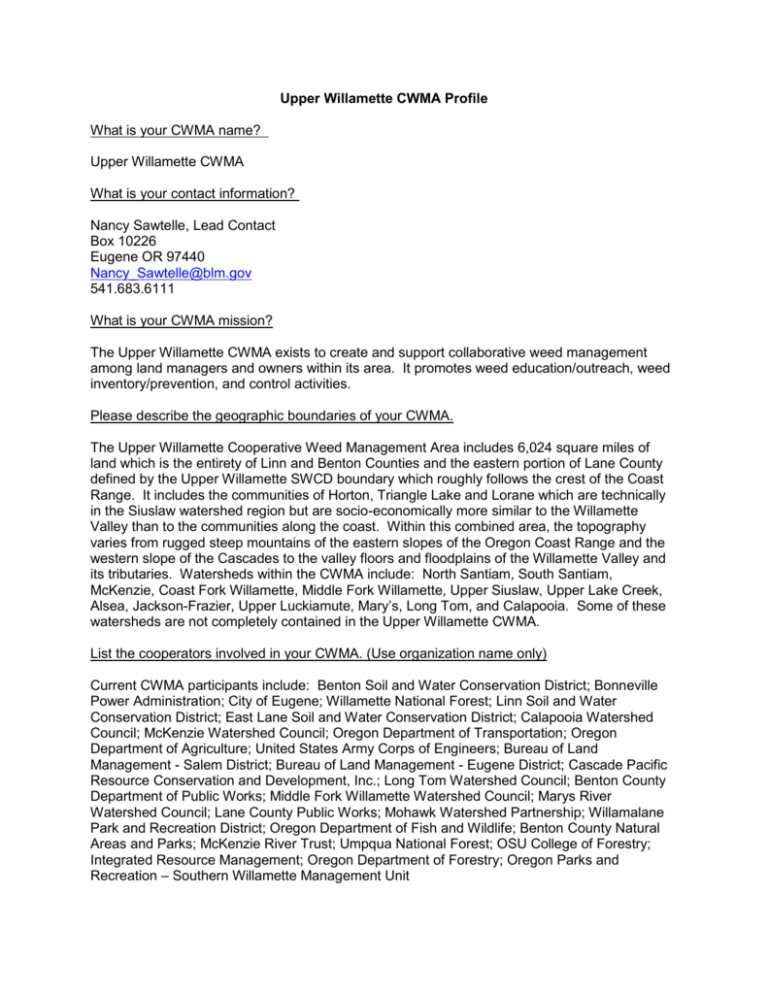
Upper Willamette CWMA Profile What is your CWMA name? Upper Willamette CWMA What is your contact information? Nancy Sawtelle, Lead Contact Box 10226 Eugene OR 97440 Nancy_Sawtelle@blm.gov 541.683.6111 What is your CWMA mission? The Upper Willamette CWMA exists to create and support collaborative weed management among land managers and owners within its area. It promotes weed education/outreach, weed inventory/prevention, and control activities. Please describe the geographic boundaries of your CWMA. The Upper Willamette Cooperative Weed Management Area includes 6,024 square miles of land which is the entirety of Linn and Benton Counties and the eastern portion of Lane County defined by the Upper Willamette SWCD boundary which roughly follows the crest of the Coast Range. It includes the communities of Horton, Triangle Lake and Lorane which are technically in the Siuslaw watershed region but are socio-economically more similar to the Willamette Valley than to the communities along the coast. Within this combined area, the topography varies from rugged steep mountains of the eastern slopes of the Oregon Coast Range and the western slope of the Cascades to the valley floors and floodplains of the Willamette Valley and its tributaries. Watersheds within the CWMA include: North Santiam, South Santiam, McKenzie, Coast Fork Willamette, Middle Fork Willamette, Upper Siuslaw, Upper Lake Creek, Alsea, Jackson-Frazier, Upper Luckiamute, Mary’s, Long Tom, and Calapooia. Some of these watersheds are not completely contained in the Upper Willamette CWMA. List the cooperators involved in your CWMA. (Use organization name only) Current CWMA participants include: Benton Soil and Water Conservation District; Bonneville Power Administration; City of Eugene; Willamette National Forest; Linn Soil and Water Conservation District; East Lane Soil and Water Conservation District; Calapooia Watershed Council; McKenzie Watershed Council; Oregon Department of Transportation; Oregon Department of Agriculture; United States Army Corps of Engineers; Bureau of Land Management - Salem District; Bureau of Land Management - Eugene District; Cascade Pacific Resource Conservation and Development, Inc.; Long Tom Watershed Council; Benton County Department of Public Works; Middle Fork Willamette Watershed Council; Marys River Watershed Council; Lane County Public Works; Mohawk Watershed Partnership; Willamalane Park and Recreation District; Oregon Department of Fish and Wildlife; Benton County Natural Areas and Parks; McKenzie River Trust; Umpqua National Forest; OSU College of Forestry; Integrated Resource Management; Oregon Department of Forestry; Oregon Parks and Recreation – Southern Willamette Management Unit List the weed species of concern for your CWMA. Appendix 1: Weeds of concern WEEDS OF CONCERN: Upper Willamette Cooperative Weed Management Area 2007 1 UWCWMA status: 1=New invaders; 2=locally established; 3=widely established; W=watch list 2 UWCWMA “dirty two dozen”: average rank of time and money spent by partners responding to 2006 questionnaire. The top five species are highlighted. COMMON NAME SPECIES List1 Rank ODA 20062 List 1: New Invaders in the Upper Willamette Garlic mustard Portuguese broom French broom Alliara petiolata Cytisus striatus Genista monspessulana (= Cytisus monspessulanus) Shining cranesbill Geranium lucidum Giant hogweed Heracleum mantegazzianum Hawkweed complex Hieracium aurantiacum, H. floribundum Water primrose willow Ludwigia peploides Yellow floating heart Nymphoides peltata Sulfur cinquefoil Potentilla recta Spanish broom Spartium junceum Gorse Ulex europaeus List 2: Locally Established in the Upper Willamette 1 1 1 1 1 1 1 1 1 1 1 15 22 24 False-brome Brachypodium sylvaticum Distaff thistle Carthamus lanatus Diffuse knapweed Centaurea diffusa Spotted knapweed Centaurea maculosa Meadow knapweed Centaurea pratensis Common fennel Foeniculum vulgare Yellow flag iris Iris pseudacorus Sweet pea Lathyrus latifolius Ox-eye daisy Leucanthemum vulgare Purple loosestrife Lythrum salicaria Harding grass Phalaris aquatica Japanese, giant, hybrid Polygonum cuspidatum*, sachalinense*, X knotweeds bohemicum Himalayan knotweed Polygonum polystachyum List 3: Widely Established in the Upper Willamette 2 2 2 2 2 2 2 2 2 2 2 2 1 13 10 20 5 B A B B B NL B NL NL B, T NL *B, T 2 8 B Bentgrass (escaped, non-ag pops) Butterfly bush Canada thistle Bull thistle English/single seed hawthorn Scotch broom Herb Robert English and Irish ivy Agrostis capillaris, stolonifera, alba, tenuis, 3 11 NL Buddleja davidii Cirsium arvense Cirsium vulgare Crataegus monogyna Cytisus scoparius Geranium robertianum Hedera helix*, hibernica 3 3 3 3 3 3 3 12 B B B NL B NL *B 16 19 21 17 18 9 3 7 6 B, T B B NL A, T A, T NL A B B B, T WEEDS OF CONCERN: Upper Willamette Cooperative Weed Management Area 2007 1 UWCWMA status: 1=New invaders; 2=locally established; 3=widely established; W=watch list 2 UWCWMA “dirty two dozen”: average rank of time and money spent by partners responding to 2006 questionnaire. The top five species are highlighted. COMMON NAME SPECIES List1 Rank ODA 20062 English holly Ilex aquifolium 3 NL 4 Reed canary grass Phalaris arundinacea 3 NL Laurel Prunus laurocerasus 3 NL Feral pear Pyrus communis 3 NL Multiflora rose Rosa multiflora 3 14 NL 2 Armenian & Evergreen Rubus armeniacus (=R. discolor), R. 3 B blackberries laciniatus Watch List Tree of Brooklyn Common bugloss Plumeless thistles Starthistle, yellow* Old man's beard Jubata grass Spurge laurel Patterson’s curse Weeping lovegrass Creeping velvet grass Hydrilla Policeman’s helmet Thin-leaved pea Bristly oxtongue Fig buttercup Creepy buttercup Purple oyster plant Ailanthus altissima Anchusa officinalis Carduus tenuiflora & C. pycnocephala Centaurea solstitialis Clematis vitalba Cortaderia jubata Daphne laureola Echium plantagineum Eragrostis curvula Holcus mollis Hydrilla verticillata Impatiens glandulifera Lathyrus sylvestris Picris echioides Ranunculus ficaria Ranunculus repens Tragopogon porrifolius W W W W W W W W W W W W W W W W W 23 WEEDS FOR DISCUSSION (Weeds proposed during 2006 management ranking process, but lacking a proponent at list revision meetings) Wild oats Avena fatua Cheatgrass and other annual Bromus spp. bromes Teasel Dipsacus sativum (=D. sylvestris?) Annual bluegrass Poa annua Black locust Robinia pseudoacacia Puncturevine Tribulus terrestris What is the highest priority species in your area? False brome What makes the structure of your CWMA successful? Multiple partners from a wide range of local, county, state and federal organizations allow for NL B, T NL B, T B B NL A, T NL NL A B NL NL NL NL NL sharing to technical information, maps, outreach materials, etc What are some of your most successful on the ground accomplishments? Various watershed-wide knotweed and false brome projects involving multiple agencies. Describe your most valuable outreach/education tool. Field visits and tours! What would you say is your CWMA's largest obstacle in the way of achieving your mission? Lack of long term funding prevents ongoing monitoring and follow up needed to successfully see a project through. List your highest priority on the ground projects and why they are high priority. (for instance T&E species, sensitive habitat protection...something like that) Japanese knotweed and false brome due to their propensity to form monocultures; this is severely detrimental to fish and wildlife habitat.

